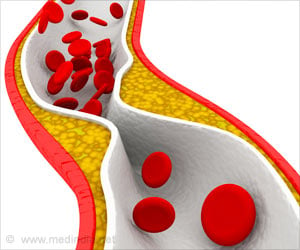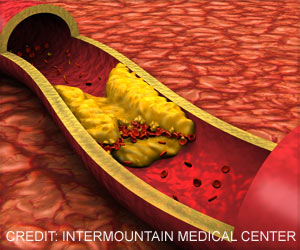Scientists have discovered risk factors that are more likely to trigger a heart attack or acute myocardial infarction (AMI) for men and women.

‘Raising awareness about the incidence of heart attacks in younger women is a key part of the strategy, she said. The next frontier of cardiovascular disease prevention in young women could be better understanding the role of women-related factors.’





The study was published in JAMA Network Open. While heart attacks are often associated with older adults, this population-based case-control study examined the relationship between a wide range of AMI-related risk factors among younger adults. The researchers used data from 2,264 AMI patients from the VIRGO (Variation in Recovery: Role of Gender on Outcomes of Young Acute Myocardial Infarction Patients) study and 2,264 population-based controls matched for age, sex, and race from the National Health and Nutrition Examination Survey (NHANES).
The key finding is that young men and women often have different risk factors. Seven risk factors — including diabetes, depression, hypertension or high blood pressure, current smoking, family history of AMI, low household income, and high cholesterol — were associated with a greater risk of AMI in women. The highest association was diabetes, followed by current smoking, depression, hypertension, low household income, and family history of AMI. Among men, current smoking and family history of AMI were the leading risk factors.
Rates of AMI in younger women have increased in recent years said Yuan Lu, an assistant professor at Yale School of Medicine and the study’s lead author.
“Young women with AMI are an unusual or extreme phenotype on account of their age,” she said. “In the past, we found that young women, but not older women, have a twice higher risk of dying after an AMI than similarly aged men. In this new study, we now identified significant differences in risk factor profiles and risk factor associations with AMI by sex.”
Advertisement
“This study speaks to the importance of specifically studying young women suffering heart attacks, a group that has largely been neglected in many studies and yet is about as large as the number of young women diagnosed with breast cancer,” said Dr. Harlan M. Krumholz, the Harold H. Hines Jr. Professor of Medicine at Yale, director of the Center for Outcomes Research and Evaluation (CORE), and senior author of the paper.
Advertisement
Accounting for AMI subtypes may also be effective. The researchers found that many traditional risk factors including hypertension, diabetes, and high cholesterol, are more prevalent in type-1 AMI, whereas different AMI subtypes — including type-2 AMI (a subtype associated with higher mortality) — are less common.
“We are moving more towards a precision medicine approach, where we are not treating each patient the same, but recognizing that there are many different subtypes of AMI,” Lu said. “Individual-level interventions are needed to maximize health benefits and prevent AMI.”
The study is among the first and the largest in the United States to comprehensively evaluate the associations between a wide range of predisposing risk factors and incident AMI in young women and a comparable sample of young men. The study design also included a comparable population-based control group from the National Health and Nutrition Examination Survey, a program to assess demographic, socioeconomic, dietary, and health-related information.
Heart Attack in Women
A longitudinal study is traditionally used to assess AMI risk in younger populations. Because the incidence rate is low in young people, however, it takes a long time for the disease to manifest. So researchers often don't have enough AMI events to make inferences about risk factors and their relative importance in young women and men, said Lu.“Here we used a novel study design with a large cohort of patients with AMI and then we identified age-sex-race matched population control from a national population survey to compare this with, and we used a case-control design to evaluate the association of these risk factors with AMI,” said Lu. “This is one of the first and largest studies to address this issue comprehensively.”
In the United States, hospitalization rates for heart attacks have been decreasing with time, according to research in the journal JAMA Cardiology.
“However, if you analyze the proportion of these patients by age, you will find that the proportion of younger people who are hospitalized for heart attack is increasing,” said Lu. “So it seems there's a general trend for AMI to happen earlier in life, so that makes prevention of heart attack in younger people, especially important.”
Younger women represent about 5% of all heart attacks that occur in the U.S. each year. “This small percentage effects a large number of people because so many AMIs occur in the US each year,” she said. “There about 40,000 AMI hospitalizations in young women each year, and heart disease is the leading cause of death in this age group.”
Lu emphasized the importance of education. “When we talk about heart attack in young women, people are often not aware of it,” she said. “If we can prevent women from having heart attacks that will improve outcomes.”
Previous studies have shown that women-related factors may be associated with risk of heart attack, but there is limited data on women under the age of 55. “We hope to explore women-related factors including menopausal history, pregnancy, menstrual cycle, and other factors that are specifically related women and analyze whether that's contributing to the risk of heart attack,” she said.
The study team also included Shu-Xia Li, Yutian Liu, Rachel P. Dreyer, Rohan Khera, Karthik Murugiah, Gail D’Onofrio, Erica S. Spatz, all from Yale; Fatima Rodriguez from Sandford University; Karol E. Watson from the University of California, Los Angeles; and Frederick A. Masoudi from Ascension Healthcare. The VIRGO study was funded by the US National Institutes of Health.
Source-Eurekalert












